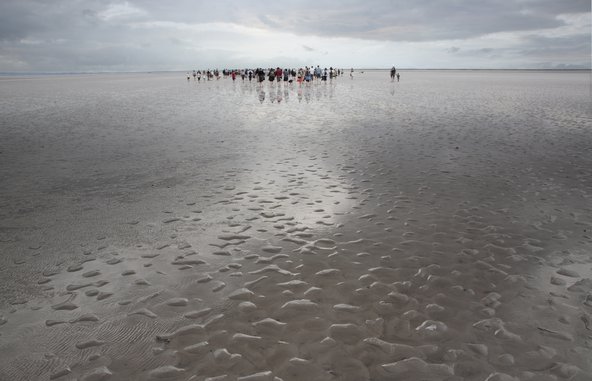The artist Patricia Townsend writes about her moving image On the Shores.

"On the Shores is the first in a series of moving image works related to Morecambe Bay, a vast area of quicksands, hidden channels and rapid tidal flow, situated just south of the English Lake District. I have been going to the area for many years, staying in a valley halfway between the mountains and the Bay, and I often walk in the mountains nearby. To me the mountains are not only beautiful but also solid, dependable, somehow containing. But they did not move me to make artworks despite the fact that most of my work is related to landscape. They seemed to be weighted down by their Romantic heritage as if there was no room for me to find a different view. Some time passed before I became aware that I was avoiding turning in the other direction, towards Morecambe Bay. The Bay has its own beauty but I began to recognise that it also troubled me deeply. It seemed too open, too flat, too uncontained, too threatening. Looking out over the great expanse of the Bay at low tide, I imagined myself walking out alone towards the horizon until I could see no land. I imagined what it might feel like to be out in this wet desert, far from help. This sense of isolation and lack of containment seemed to be one aspect of my emotional reaction to the Bay. Another had to do with the imagined experience of being sucked beneath the ground by quicksands. Or being swept away, engulfed, by the incoming tide which is said to be as fast as a galloping horse. I felt that these emotional reactions, these emotionally charged images, were the tip of an iceberg and that below this were less conscious associations which I could not yet access. It was this sense that there was more for me to understand that pushed me to want to make an artwork.
I began to explore the Bay by taking photographs and videos, becoming familiar with the movement of the tides and finding vantage points at the mouth of an estuary from which I could film the dramatic surge when the incoming tide meets the outgoing river. I also took many still photographs, crossing the Bay on foot with the Guide-over-Sands who marked out a safe passage through the quicksands. But the many films I made and the photographs I took did not seem, in themselves, to capture the feelings the Bay engendered in me. It was not until I had the idea of combining still and moving images that the developing artwork began to come to life. As I worked on the editing of the piece, it began to embody some of the associations I had sensed but been unable to name. I gradually came to recognize something of myself in the work (though I could not necessarily give verbal expression to whatever it was that I recognized).
The title of the work is taken from a poem by Rabindranath Tagore that includes the words: ‘On the seashore of endless worlds children play’. The psychoanalyst and paediatrician D.W. Winnicott came across this poem as an adolescent and these words ‘found a place in him’ although, at the time, he could not have said what they meant. Much later, he came to write about an intermediate area of experience, that he called transitional or potential space, where inner and outer reality overlap. Morecambe Bay, for me, is not only an external landscape but also, and at the same time, a space of imagination. The title On the Shores refers to the Bay, and the resulting artwork, as liminal spaces between inner and outer worlds."